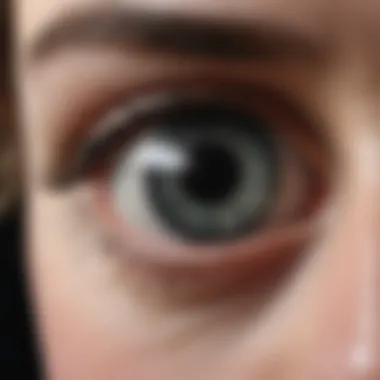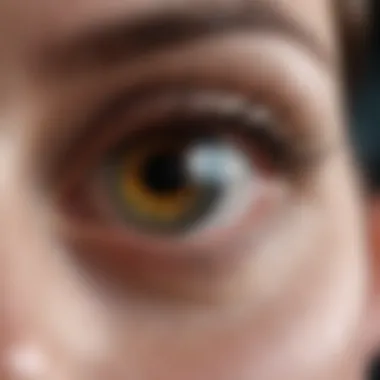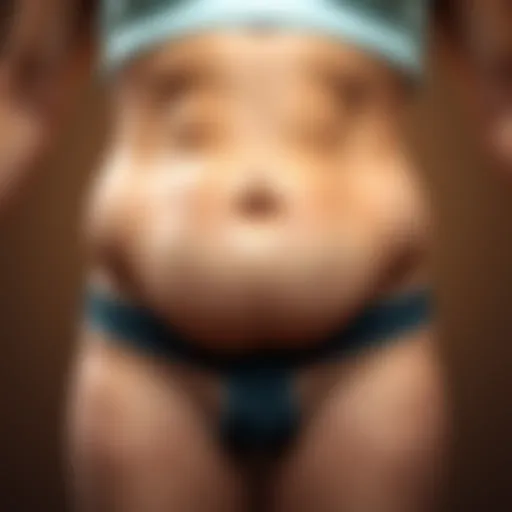Understanding Mono Pupillary Distance: Role and Measurement


Intro
Mono pupillary distance (MPD) is an essential measurement in the world of optometry, often wielded with precision to tailor optical prescriptions effectively. It's a seemingly simple metric, yet it carries significant weight in ensuring optimal visual comfort and clarity. By understanding MPD, we can get a clearer picture of its implications for both patients and practitioners alike.
The interaction between light, lenses, and the human eye can be intricate, tailored to the unique characteristics of each individual. MPD serves as a fundamental building block in this complex interaction. With accurate measurements, we can enhance the fitting of eyeglasses and contact lenses, which ultimately impacts a patient's visual health. This article dives deep into the nuances of MPD, touching on its measurement techniques, importance in optical prescription accuracy, and how variations in readings can affect various fields from optical device design to education in vision science.
For students, researchers, educators, and professionals, grasping the full scope of MPD is essentially like holding a key to precision in visual acuity. Let's embark on this journey to unpack its significance and the methodologies involved in measuring this critical parameter.
Defining Mono Pupillary Distance
Mono pupillary distance (MPD) is a specialized measurement that reflects the distance from the center of one pupil to the corresponding side of the bridge of the nose. Understanding this dimension is crucial for various aspects of optometry, particularly when it comes to tailoring optical devices and prescriptions for individual needs. Accurate measurement of MPD plays an important role in ensuring that optical lenses, like glasses, align perfectly with the wearer's eyes, enhancing both comfort and visual clarity.
Importance of Mono Pupillary Distance
The significance of mono pupillary distance can’t be overstated. First and foremost, it directly influences the optical performance of eyewear. If the lenses are not correctly aligned with the pupils, it can lead to distorted vision or discomfort. It would be akin to trying to drive a car with misaligned wheels—inevitably, the journey becomes bumpy and unpleasant. Moreover, a trustworthy measurement of MPD contributes to the precision of prescription filling. This is particularly vital for patients requiring specialty lenses, such as those for myopia or astigmatism, where even slight discrepancies could hinder visual comfort.
In addition, having a solid grasp on MPD allows optometrists to create personalized eyewear solutions. For example, when crafting eyewear with certain designs, understanding an individual’s MPD can lead to aesthetics that not only look appealing but also offer comfort in use. The right fit can transform the wearer's experience, making it blissful rather than burdensome.
Whether it’s for a child getting their first pair of glasses or an adult needing corrective lenses for specific tasks, measuring MPD is a cornerstone of providing effective, individualized optical solutions.
Differences between Pupillary Distance and Mono Pupillary Distance
It’s essential to differentiate between general pupillary distance (PD) and mono pupillary distance. While PD refers to the measurement between the centers of the pupils, encompassing both eyes, mono pupillary distance hones in on one specific eye at a time. This specificity matters because:
- Directionality: Mono pupillary distance informs the optician about how to center the lens accurately on an individual’s unique face shape.
- Customization: Especially in complex prescriptions, knowing each eye's distance helps in optimizing lens performance tailored to ocular positions.
- Clarity: Often, discrepancies between the two measurements can yield less-than-ideal results. By solely focusing on one eye, practitioners can secure more precise alignment.
In summary, while both measurements are valuable, understanding mono pupillary distance brings a finer lens into account, ensuring that optical solutions meet the distinct needs of every individual user. This ensures that all optical devices not only support vision needs but also enrich the overall wearing experience, keeping both functionality and comfort at the forefront.
"The accurate assessment of mono pupillary distance is not just a number; it is pivotal in shaping how we perceive our visual world."
By diving deeper into these concepts, one can start to appreciate the subtleties involved not only in measurement but in the meaningful application of this knowledge to real-world scenarios.
Measurement Techniques for MPD
Understanding how to properly measure mono pupillary distance (MPD) is significant for various applications in the field of optometry. Accurate measurement techniques ensure that prescriptions and eyewear designs meet the unique needs of individuals. Inaccurate measurements can lead to discomfort, improper lens fitting, or subpar visual performance, which is unacceptable when it comes to eye care.
By diving into the measurement techniques for MPD, practitioners can enhance their skills and ensure better outcomes for their patients. Knowing the right methods not only improves efficiency but also promotes a deeper grasp of the physical nuances that can affect measurements. In essence, mastering MPD techniques is crucial for anyone seriously involved in optometry or eyewear manufacturing.
Traditional Methods of Measuring MPD


When it comes to traditional methods, there are a couple of straightforward techniques that have stood the test of time. They often involve simple tools such as rulers or pupillometers.
- Using a Ruler: One common approach is to use a standard ruler. An individual can sit comfortably, look straight ahead, and the ruler is positioned just below the eyes. The distance between the pupils can be measured in millimeters, giving a direct measurement of the MPD. This method is both straightforward and cost-effective, relying on basic geometry. However, accuracy hinges on the ruler's alignment and the measurement skills of the person doing it.
- Pupillometry: A more sophisticated method involves the use of a pupillometer, which is specifically designed for this purpose. This device measures the distance electronically, often providing readings with greater precision than manual methods. A pupillometer takes into account the natural alignment and position of the eyes better than the ruler method.Traditional techniques have their place in optometry, but they also come with their own sets of limitations, which leads us to the evolution toward digital solutions.
Use of Digital Tools in MPD Measurement
The emergence of technology has revolutionized the way we measure mono pupillary distance. Digital tools offer enhanced accuracy and ease of use, often improving upon the more archaic methods previously discussed.
- Digital Pupillometers: These devices leverage digital imaging and calculations, allowing for quick and highly accurate measurements. They can often account for individual variations in pupillary alignment automatically, reducing human error.
- Mobile Applications: With the proliferation of smartphones, several applications can now provide MPD measurements using the phone's camera. Users follow a series of guided steps—often involving marking their eyes—and the app performs the calculations. Although these may not be as accurate as professional tools, they offer convenience for non-professionals or in informal settings.
While digital tools significantly boost precision and simplify the process, it’s still important to recognize the potential pitfalls. For instance, not all mobile applications are created equal, and their accuracy can be influenced by factors like distance from the camera and calibration issues.
In sum, understanding both traditional and digital measurement techniques provides a well-rounded view of how to best gauge mono pupillary distance. This knowledge equips dedicated practitioners with the tools needed to provide individual-focused care, ultimately enhancing the overall experience for patients seeking eye care solutions.
Applications of Mono Pupillary Distance
The concept of mono pupillary distance (MPD) holds significant relevance across multiple sectors within optometry and ocular health. Understanding MPD is not just about measurement; it's about its application in real-world scenarios that affect people's daily lives. The precise calculation of an individual’s MPD can be the differentiator for achieving optimal vision correction and ensuring comfort in eyewear usage.
MPD in Optical Prescription Filling
When it comes to optical prescriptions, knowing the correct MPD helps professionals fill glasses accurately. The effectiveness of multifocal lenses relies heavily on precise measurements. If the MPD is off, the lenses won't align with the pupil. This misalignment can lead to discomfort and ineffective vision correction. So, getting this measurement right is paramount.
Furthermore, some patients may require specialized prescriptions that require an exacting attention to MPD. For example, those with anisometropia, where there's a significant difference in the refractive power between the two eyes, may particularly benefit from well-calibrated optical devices. Here, the importance of accurate MPD measurement shows itself starkly, influencing both prescription accuracy and the overall patient experience.
Relevance of MPD in Eye Wear Design
In the world of eyewear design, MPD plays a critical role as well. Designers and manufacturers often iterate on styles that not only enhance aesthetic appeal but also ensure optimal performance based on user measurements. When designing glasses, knowing the MPD allows for a more tailored fit, enhancing both the functionality and comfort of the eyewear.
This is particularly evident in designer frames, where ergonomics and style must go hand in hand. Continuing trends also highlight the shift towards bespoke eyewear, pushing the boundaries of traditional one-size-fits-all solutions. As consumers become more discerning, the relevance of MPD in ensuring satisfaction with eyewear choices cannot be understated.
MPD Considerations in Customized Vision Aids
Customization is increasingly paramount in the realm of vision aids. Devices such as binoculars, VR headsets, and professional-grade optical instruments now frequently capitalize on the precision of MPD. Any slight deviation can substantially affect user experience, leading to strain and discomfort.
For example, in assistive technology for the visually impaired, devices that incorporate MPD calculations can allow for a more personalized interaction. Tailoring vision aids to the user’s specific MPD opens doors to enhanced usability, improving daily activities for individuals who may otherwise struggle.
In short, the applications of MPD extend far beyond the ocular exam room, deeply influencing trends in prescription filling, eyewear design, and customized devices. As our understanding of MPD grows, so too does our capacity to cater to the nuanced needs of diverse populations.
"The accurate measurement of mono pupillary distance serves not just as a tool for optometrists, but as a bridge to improved visual acuity for patients needing it most."
Through these lenses, one can see that the significance of MPD in applications is not merely academic but profoundly practical.


Factors Influencing Mono Pupillary Distance
When we talk about mono pupillary distance (MPD), it's essential to understand that various factors can play a significant role in its measurement and interpretation. These influences can vary widely from one individual to another. Gaining insight into these elements not only helps practitioners deliver better care but also enhances optometric research. By grasping the nuances of MPD, professionals can ensure more precise fitting of spectacles and other visual aids, leading to improved patient satisfaction.
Anatomical Variations in Pupillary Position
Not all eyes are created equal, and that's where anatomical variations come in. Pupillary position can differ based on a myriad of factors, including genetics, ethnicity, and even environmental influences. For example, the distance between the pupils isn't just about symmetry; it can reflect underlying anatomical differences unique to each person.
Consider this: a study may reveal that individuals with wider-set eyes might show greater variation in MPD readings compared to those whose pupils are closer together. This variation stems from how the ocular muscles and surrounding structures develop differently in various populations.
Moreover, something as seemingly small as facial structure can contribute to these differences. For instance, a person with a broader face may have a larger MPD as a natural consequence of their bone structure. Therefore, understanding these distinctions is paramount when measuring MPD, as it sets the foundation for accurate optical prescriptions. Taking these factors into account helps ensure that measurements are not merely numbers but represent the individual’s unique anatomy.
Effects of Age on MPD Measurement
Age is another crucial factor that can influence MPD measurements. As individuals age, their physical specifications often evolve, including the positioning of the pupils. For older adults, changes brought about by common refractive errors or even age-related conditions can alter pupillary distance dimensions.
For instance, younger children may have greater variability in their MPD as they are still growing, which complicates accurate measurements. Meanwhile, in adults, particularly those over fifty, natural changes such as presbyopia might lead to adjustments in the visual center, indirectly reflecting in their MPD readings. These subtle shifts can cause complications when updating prescriptions based on prior measurements.
Furthermore, it's worth noting how common conditions like cataracts can affect the perceived distance. If the lens becomes opaque, deviations may happen that require adjustments to the established MPD. Doing thorough assessments at different life stages becomes vital to ensure that optical devices or visual aids still function effectively.
In summary, recognizing the impact of both anatomical variations and age can aid practitioners in providing tailored solutions and ultimately enhancing the optical experience of their patients. Be informed, be precise!
Special Considerations for Measuring MPD
Measuring Mono Pupillary Distance (MPD) doesn’t follow a one-size-fits-all approach, especially when factoring in special populations. Each individual comes with unique anatomical features, behaviors, and needs that can greatly influence the measurement process. It’s essential to recognize these variations to ensure accuracy and reliability in measurements and, ultimately, in optical prescriptions and device designs.
MPD Measurement in Pediatric Populations
When it comes to children, measuring MPD can be quite a challenge, but it’s also profoundly important. Children's eyes are not just smaller versions of adults’, but they are also in a stage of growth and development. This ongoing change can affect the positioning of the pupils, and thus, their MPD. Determining an accurate MPD in young ones can prevent future optical issues and misfitting glasses.
To effectively measure MPD in children:
- Engage in a Playful Approach: It often helps to create a relaxed atmosphere. Distracting them with toys or gently chatting can minimize anxiety, allowing for a more accurate measurement.
- Use Adapted Tools: Instruments that are friendly for children's sizes can make a big difference. Conventional tools may not suit smaller facial structures.
- Frequent Reevaluation: Since their physical features are changing, measuring their MPD periodically ensures their glasses or optical solutions remain appropriate.
In essence, taking these particular tactics into account can mean the difference between a comfortable fit and one that leads to frustration and dependence on improper optical aids.
Challenges in Measuring MPD for Special Needs Individuals
Measuring MPD for individuals with special needs presents its own set of hurdles, requiring a tailored approach. Variations in cognitive ability, motor skills, and physical conditions might impact how a person responds to standard measurement techniques. It’s a balancing act: ensuring precision while accounting for each unique circumstance.
Here are some considerations when working with special needs individuals:


- Personalized Setup: Different environments work for different people. Ideally, find a space where they feel most at ease.
- Adjust Measurement Techniques: Some may need assistance in stabilizing their head or understanding the measurement process itself. Adapting your approach based on their responses is crucial.
- Utilization of Adaptive Tools: Devices may need modifications for them to be useful. Specialized measurement tools exist that cater to these needs, potentially simplifying the process.
"Every individual is unique. Recognizing and adapting to this diversity in measurement approaches leads to better optical outcomes."
Optimal MPD measurements in special populations are not just about obtaining numbers; they are about comprehensively understanding and respecting the individual’s unique requirements. Engaging with these populations requires commitment and a willingness to learn.
Research Landscape Surrounding Mono Pupillary Distance
The landscape of research focusing on mono pupillary distance (MPD) has evolved significantly, finding its way into various subfields within optometry and ocular health. Understanding this topic is crucial for several reasons. First, it holds vast implications for optometric practice, as accurate measurements can directly influence visual comfort and the efficacy of optical devices.
Moreover, research in this area paves the path for innovations in instrumentation and enhances the overall quality of patient care. As our knowledge deepens, we see significant advancements, not only in methodologies of measuring MPD but also in addressing the unique challenges posed by diverse populations. This lays a foundation for further advancements in both diagnosis and treatment strategies, benefiting practitioners and their patients alike.
Current Trends in MPD Research
Current trends in MPD research are revealing some fascinating insights. For instance, there’s a growing interest in using digital imaging technology and machine learning algorithms to streamline the measurement process. Such innovations not only improve accuracy but also enhance efficiency, particularly in high-demand clinical settings.
Furthermore, researchers are investigating the relationship between MPD and various ocular conditions, exploring how certain eye disorders can alter pupillary positioning. This intersection of clinical findings and technological advancements is leading to intriguing discussions in optometric circles. Beyond practice, studies are being published that focus on how environmental factors, like screen usage and lighting conditions, affect MPD measurements over time. This focus on longitudinal studies signifies a shift towards understanding the complexity of eye health in an ever-changing world.
Future Directions for MPD Studies
Looking ahead, the future directions in MPD studies seem promising. One anticipated development is the establishment of standardized measurement protocols that could bring consistency to how MPD is assessed across the globe. Such guidelines would not only benefit practitioners but also enhance research comparability, paving the way for larger collaborative studies targeting MPD's implications.
Moreover, further research could delve into demographic variations in MPD across different populations. Factors like ethnicity, age, and even socioeconomic status could offer novel insights into how ocular measurements vary and what that means on a practical level.
Emerging methods for conducting real-time measurements in patients during eye exams are also on the radar. Imagine a world where practitioners can instantly measure MPD using mobile devices or augmented reality tools during routine check-ups. This futuristic approach could reduce the margin of error and make MPD assessments more routine.
"The minute we redefine and refine our approaches to measuring Mono Pupillary Distance, we not only enhance our understanding but also foster greater patient outcomes."
In summary, the landscape surrounding mono pupillary distance research is vibrant and ripe with opportunity. Ongoing studies are set to influence not just theoretical aspects but practical applications too, leaving a lasting impact on optometry as a whole.
End and Implications
Summarizing the Importance of Accurate MPD Measurement
Accurate MPD measurement is essential for several reasons:
- Vision Clarity: Proper MPD ensures that lenses are positioned adequately in front of the eyes, providing clear sight and reducing strain.
- Personalization: Each individual has unique anatomical features. Accurate MPD measurement allows for more tailored optical solutions.
- Enhanced Comfort: By ensuring the optical centers of the lenses are aligned with the pupils, discomfort from improper fitting can be mitigated.
Moreover, considering variations in anatomical structures or the age of a patient can further refine MPD measurements. As people get older, changes can occur that might affect their MPD, thus influencing how prescriptions should be crafted. Failure to consider these factors may lead to less satisfactory visual experiences.
Potential Developments in Optical Science Linked to MPD
The field of optical science is on the brink of numerous innovative developments related to MPD. These could include:
- Digital Eye Testing: There's a growing trend towards utilizing advanced technology such as AI and machine learning in measuring MPD. This can create more streamlined and accurate measurements, enhancing efficiency in optical practices.
- Custom Lens Design: Advances in personalized lens technologies may allow for designs that are specifically customized based on an individual's MPD, age, and other physiological factors.
- Increased Research: Future studies might delve deeper into how variations in MPD across different populations impact prescription filling and wear. Understanding these differences can influence broader trends in optical device design.
In summary, the implications of understanding and measuring MPD reach far beyond just fitting lenses. They touch upon the intricate interplay between eye anatomy and vision science, paving the way for future advancements that promise to revolutionize optical care.















